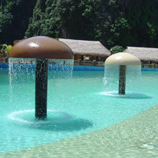ECAS Principle

The technology is called the Electrochemical Activation of Solutions (ECAS). Water or water solution is treated with electricity in a special electrochemical module. This module has two interior chambers (the cathode and the anode), which are separated by a thick diaphragm that only allows penetration at the ion level.
When the water or water solution flows through the module, it gets treated either by the cathode or the anode. This type of treatment is called unipolar. No additional chemical substances are added during the activation.
As a result of the treatment different properties of water and water solutions are modified, such as the pH, Redox, and molecule structure. The liquid achieves increased reactive properties and becomes either activated drinking water with negative redox, or a safe and effective disinfectant (AQUAECA -- HOCL anolyte ). Another product of ECAS is catholyte – an efficient deoxidizer and washing solution with high pH.
An important consideration is that the effect on ECAS products is temporal. After a period of time (from 6 months to a year) AQUAECA -- HOCL anolyte products come deactivated and dissociate into the input products. That explains why ECAS products are environmentally friendly.





